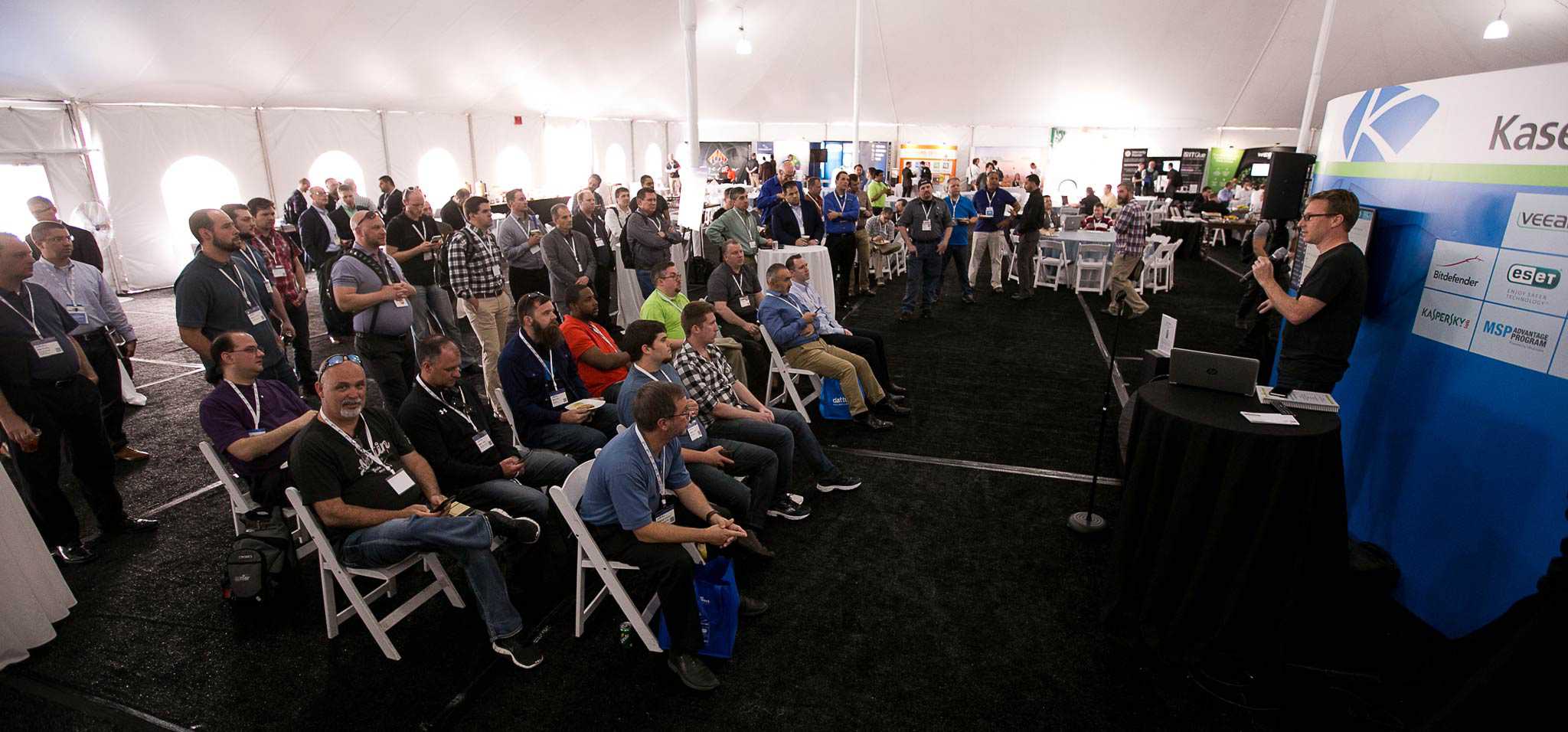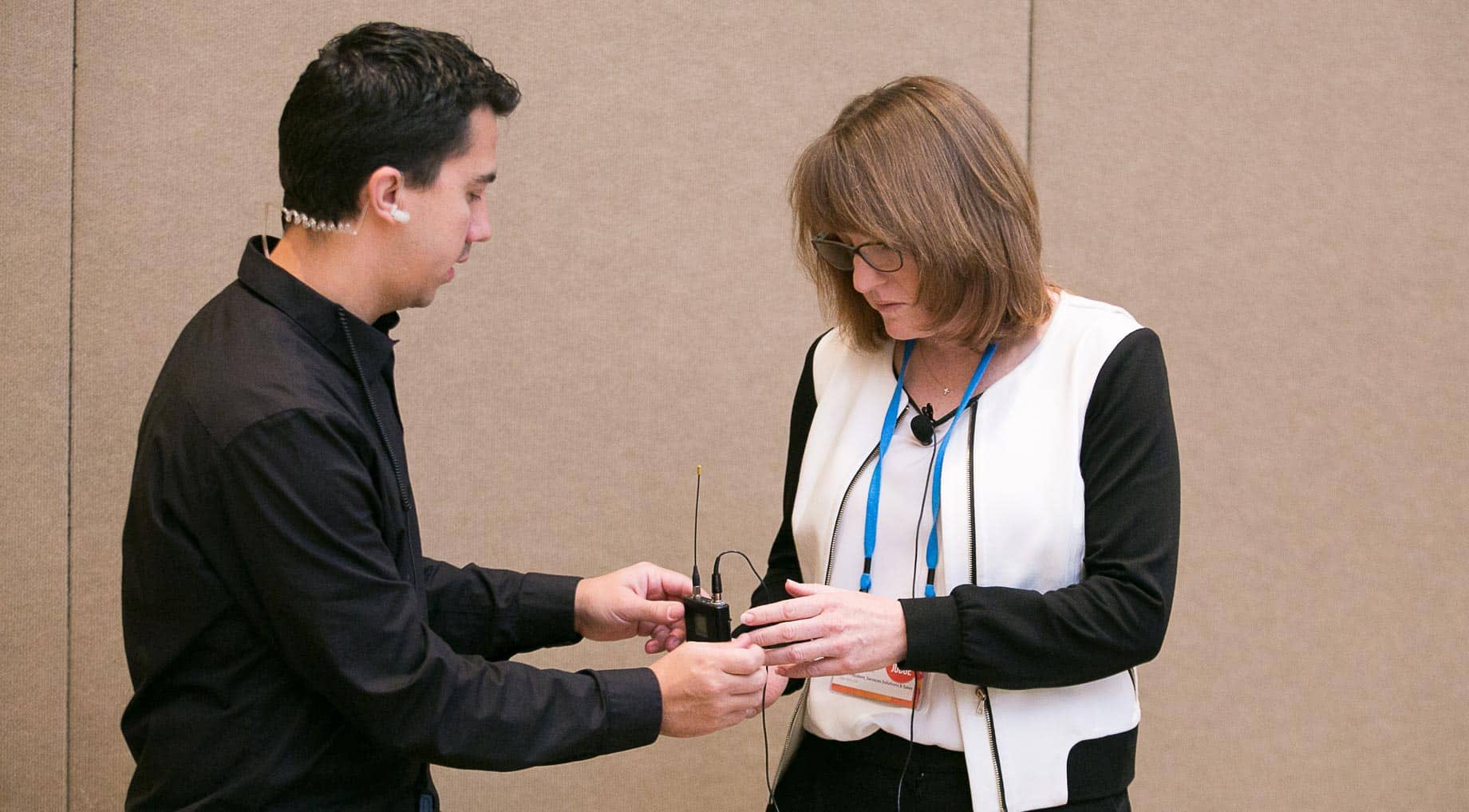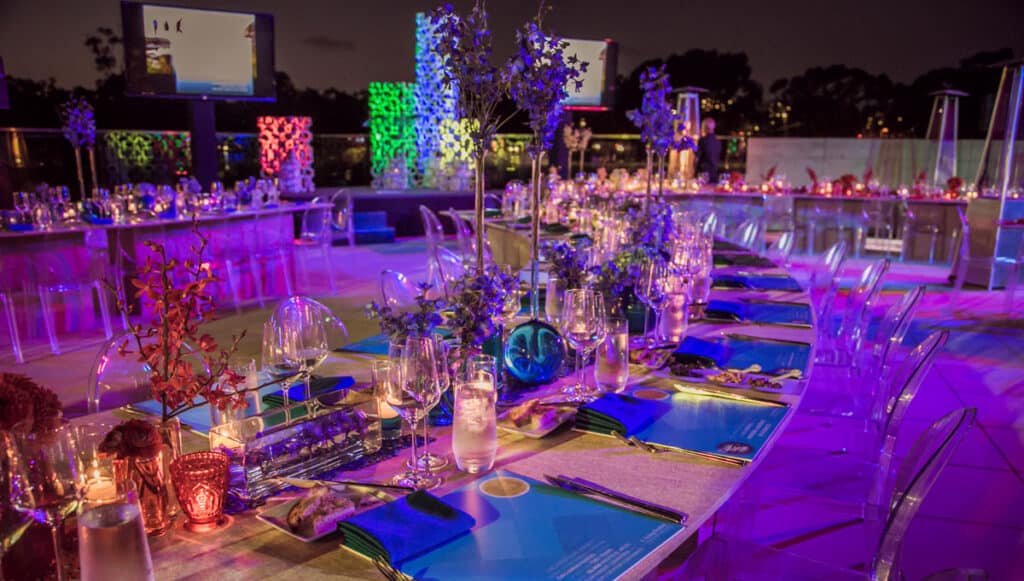The events industry is constantly evolving. But, there is a universal truth when it comes to corporate event production: visuals, particularly when paired with audio components, drive messages. Whether you’re hosting a hybrid, in-person, or virtual event, your goal should be to engage your audience with high-quality, consistent audio-visual services.
Whether your aim is making sales or presenting information, giving your audience a high-quality, consistent audio/visual experience is crucial to making sure they focus on the message, not the medium. While some event components can be expanded or contracted depending on in-the-moment need, sound, lighting and visual systems are the centerpiece to every keynote and speech, and often the sole teaching tool available to presenters for sessions and class-style presentations.
So what do you need to know to make sure that your great event leaves every attendee talking about all the right things, rather than gossiping (or worse, posting) about the wrong ones? The AV tech requirements for events will vary on several fronts – the number of attendees, for example, or the capabilities of the conference room, hotel, or virtual platform. Here’s a short list of five things you need to know about setting up audio visual technology for your event.
WHO: HIRE AN EXPERT
Every large conference room brings a flurry of AV needs from presenters and speakers, each with their own tech-compatibility quirks. This keynote presenter only has a USB flash drive, that emcee only has access to an online file with their PowerPoint, and yet another session leader is using Android or Apple-based access when the event is all but programmed for the “other” operating system. Audio visual requirements for events are never something you should be researching or discovering the day of an event!
Work on reducing the scope of these challenges by having a single, consistent point of contact for all AV-related needs and questions prior to and during your event. For the best results, look into hiring a great event production company that specializes in audio visual services, like Vario. This will ensure nothing important “falls through the cracks” as the event day looms. Additionally, the AV company will facilitate communication and avoid misunderstandings between your company and the event location staff.
WHAT: REALISTICALLY PLAN FOR WHAT YOU NEED
Much like the contents of a suitcase before a business trip, you should include everything you need in your audio-visual package, as well as some “just in case” capabilities to weather last-minute changes. When in doubt, go a little bigger, or opt for additional AV equipment whichever audio system might end up in high demand – an extra screen, additional lighting, speaker, brighter projector, or monitor can make all the difference at an event if rooms are moved, or structural acoustics end up being exceptionally poor. While duplicates of some larger, expensive pieces might not be feasible, you might be surprised at how handy an extra projection screen or two can be in the event of a last-minute lineup addition or swap-in.
With so many moving parts – literally, in some cases – the best move you can make for event success is to call in the experts. DIY approaches typically fail when the event organizer is called away to put out proverbial fires elsewhere during the live event, or unexpected obstacles crop up right before show time. For example, if an outlet turns out to be a “dud” or unable to handle the power needs of AV equipment, professional help means that an alternate power solution will be seamlessly implemented, and you’ll avoid disrupting the flow of events.
With the right kind of AV equipment – extra power cords, splitters, backups, wire covers to prevent tripping, and so on – being adequately prepared and ready to go in the event-crisis types of situations will allow your live event to continue without so much as a blink on the big screens.
WHERE: KNOW WHAT YOU’RE WALKING INTO
The larger the event, the larger the demands on an AV system. The event location’s attributes are also a determining factor in what type of AV should be used. For example, if the ballroom you booked has wrap around windows with amazing natural light, we’ll advise you to go with LED walls vs. rear projection.
If your ballroom has low ceilings, we’ll choose ground supported audio-visual equipment over rigged trussing. For these reasons and more, a professional event production company will request most venues walkthroughs during the event planning process. Room dimensions, power supply, IT infrastructure, and venue load-in restrictions should all be discussed well in advance.
WHEN: TIMING AND PRESENTATIONS
Timing is important not only during presentations, but also before and after your event as well. You will want to discuss venue hours with your event audio-visual provider to ensure they have enough time to set up and break down the AV equipment without disrupting the traffic flow of your attendees. Leave enough time for testing all components of a system the day beforehand – you don’t want to find out the hard way that glare from nearby windows will make projection text virtually unreadable!
Stand at both the front and back of the presentation space during audio checks to determine optimal volume levels; this attention to detail will prevent the last few rows of a capacity room from “leaking out” the doors due to frustration over not seeing or hearing a presentation.
HOW: MAKE A LIST AND CHECK IT TWICE
Much like any other aspect of a well-structured event, you’ll want to keep everything looking polished and running smoothly by planning ahead. Remember that single point of contact mentioned earlier? He or she should compile a cloud-accessible master list of when and where each presenter will be, as well as compiling any digital files available from presenters in the same cloud-accessible place. If a USB drive goes missing or an email file isn’t appearing where it should, having this backup can mean the difference between saving a session or looking inept in front of your audience.
Always know how each presenter is planning on running their personal segment of the show and your audio-visual programs and operators will never be caught off guard. Planning a virtual event? Pre-production coordination, logistics, and testing are even more crucial with little to no time available for making last minute changes. You’ll want to invest effort in preparing a solid Run of Show down to the second of what remote presenter should be live on screen, what content/slide should be up, and what is next on deck.

BEFORE YOUR EVENT: AN AUDIO-VISUAL TIMELINE
While this list will vary depending on the time and access you have to your venue of choice, here is a rough timeline of pre-event tasks to follow. Keep these surprisingly simple (but easy-to-overlook) deliverables in mind to ensure an optimal audio-visual experience for all your event attendees:
- One Month Out: Contact each of your speakers, confirm that they will be attending, and get rough estimates on the length of their presentations. Ideally, you should also get copies of any digital files, sound tracks, cues, transcripts, etc. at this time as well. Use this information to assign meeting rooms, confirm session tracks and schedules, and commit audio-visual event resources to the appropriate times and places during the event. Determine if the size of your audience at any given session will warrant a 1, 2, or 3-screen setup for maximum visibility.
- Three Weeks Out: Discuss AV setup and breakdown time requirements with your audio-visual providers and your venue manager, and make sure those AV requirements end up incorporated into the overall schedule. Rushing the setup of screens and speakers will lead to mistakes and potentially leave a session speaker “stranded” without the AV equipment that should have cycled to his or her presentation space.
- Two Weeks Out: Confirm with the venue that all existing components needed – chairs, tables for sound board, stands for screens and mics – will be in place. If the venue isn’t providing body and/or stage microphones as well as headset microphones, make sure your event audio-visual equipment providers have that aspect handled. Coordinate who is going to meet the AV team for the event, where they will be meeting them, and when they will need access to the event space for initial AV setup. Make sure everyone involved has one another’s phone numbers and emails to prevent last-minute miscommunications.
- One Week Out: Confirm with the venue that all existing components needed – chairs, tables for sound board, stands for screens and mics – will be in place. If the venue isn’t providing body and/or stage microphones, make sure your event audio-visual equipment providers have that aspect handled.
- Day of Event: Keep yourself available in case your well-constructed plans hit a snag; however, with thoughtful preparation out of the way, your event should look, sound, and run efficiently. Take advantage of heavy attendance in one small meeting room to test the visuals and acoustics of another prior to the next session starting. This step ensures that your event attendees are always enjoying presenters in perfect clarity.
The good news is that you don’t need to know everything about audio visual services and requirements for an extraordinary AV experience. The AV experts at Vario will address every aspect of your next corporate event, allowing you to concentrate on the bigger aspects of your affair for remarkable results. We understand the demands of events just like yours, and want to do everything in our power to make them incredible – from beautiful, crisp, clear visuals to detailed, intricate audio quality that captures the essence of your invited presenters.
With Vario, a full service event management company, you can put your worries to rest and simply enjoy your event. Whether you need audio visual for a large conference, sales meetings, or any other type of event, from projection screens and cables to speakers, we provide everything you need for a seamless experience, each and every time.
Hosting a memorable, profitable, or successful event requires a lot of teamwork and cutting edge technology, no matter what your industry or occasion might be. Make sure that you aren’t accidentally making more work for yourself by addressing these five important guidelines for your audio visual needs. Even if you’re celebrating the very first event for your company or cause, it doesn’t have to look that way – in-the-know hosts team up with professional audio-visual providers to ensure every lineup appears as though they’ve been doing it for years.
Whether you need an intimate setting or large-scale production, sights and sounds of your event should be as bold, attention-getting, and intelligent as the concepts making use of them, so make sure to add Vario to your lineup for sensational AV event technology services.

BONUS: IMPORTANT THINGS TO REMEMBER:
- It’s not uncommon for presenters to arrive digitally unprepared: Whether they’re forgetful or something important got misplaced at baggage claim, your event should always operate under the assumption they’ll need support. As far out and as often as possible, ask your presenters to send all files associated with their presentation to your specified AV contact.
- Don’t rely on the venue’s internet service: Even the best presentation equipment and audio visual event planning management can’t compensate for spotty Wi-Fi when the internet is crucial. Encourage every attendee with web-connected or live portions of their presentations to keep some screenshots or alternate content in case of connectivity issues. At the very least, these stopgaps will keep the audience focused on the presentation while the venue looks into the signal issue.
- Free Wi-Fi and/or power may not be included in your contract: This tip is particularly important to new event hosts, who may be unfamiliar with venue rentals. Often, internet and power accessibility are a separate line-item on a contract, particularly where large, professional audio visual equipment for events is concerned. Make sure you discuss and verify your needs with both your AV provider and your venue well beforehand and get everything in writing!
- Don’t assume rigging points will hold your overhead materials: Posters, props, screens, and other overhead items have wildly different weights, and it should never be assumed that a rigging point is equally suited to every weight. Know the weight, number of tether points required, and size of anything you need hung overhead, particularly when it comes to screens. Verify with your venue that their existing tether points are suitable for your materials – it helps avoid accidents and liability on both sides.
- Always bring more extension cords, high-visibility tape, and wire bridges: Large events mean a lot of foot traffic, so instruct your AV team to bring ample materials to keep wires as flat as possible. Tripping and falling hazards don’t make for an enjoyable event experience, nor does unexpected damage to AV equipment.
FREQUENTLY ASKED QUESTIONS
What Are AV Equipment Requirements?
Some sound equipment requirements include a mixer, electronic consoles or sound board to control feedback, combine audio signals, projectors, microphones, frequency band, transmitters, and adapters for the event. These types of equipment are crucial for the success of an AV event.
What Is AV Planning?
AV planning involves the organization of an event involving a variety of audio and video equipment. It’s oftentimes considered a blend between construction and event technology because it requires the setup and maintenance of cutting-edge technology and equipment. The primary goal is to ensure the event is planned and executed successfully.
What Is an AV Person?
An AV person is an event planner who is responsible for setting up and maintaining the sound equipment and video recording equipment for an event. These event planners typically operate the video recorders, projectors, microphones, external sound systems, and stage lighting equipment.







